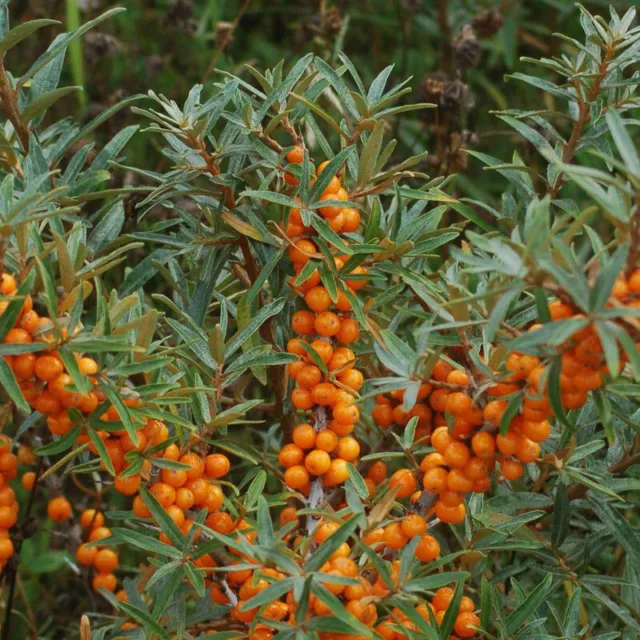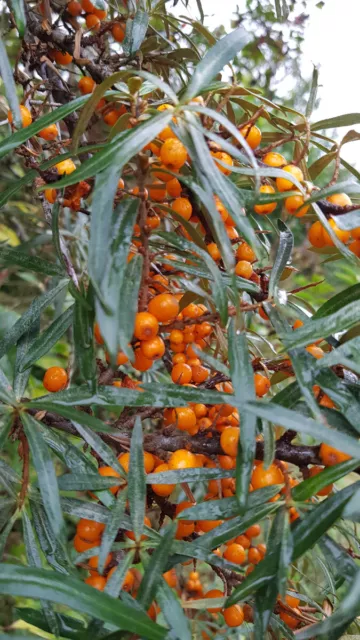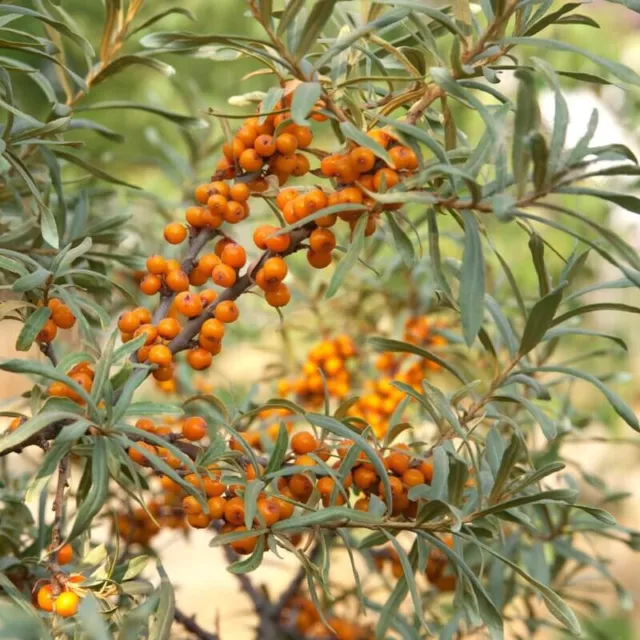Hippophae rhamnoides 15-30cm
Hippophae rhamnoides 15-30cm
Hippophae rhamnoides, commonly known as sea buckthorn, is a deciduous shrub that is prized for its nutritional and medicinal value, as well as its ornamental qualities. It is native to Europe and Asia and is known for its bright orange berries. Appearance: Sea buckthorn is a thorny, multi-stemmed shrub that can reach heights of 6 to 20 feet (1.8 to 6 meters) depending on the variety and growing conditions. The leaves are narrow, silvery-green to grayish-green, and have a distinct silvery underside. In spring, it produces small, inconspicuous, yellowish-green flowers that are dioecious, meaning there are male and female plants, and both are needed for berry production. The most striking feature of sea buckthorn is its bright orange, oval-shaped berries that cluster along the branches. These berries are rich in nutrients, including vitamins and antioxidants. Cultivation: Location: Plant sea buckthorn in a sunny location where it can receive full sun to partial sun. It requires plenty of sunlight for healthy growth and fruit production. Soil: Sea buckthorn prefers well-draining soil and can tolerate a wide range of soil types, including sandy and loamy soils. It can even tolerate poor or saline soils, making it suitable for coastal areas. Watering: While sea buckthorn is relatively drought-tolerant once established, it benefits from regular watering, especially during dry spells and the first growing season after planting. Water deeply to encourage a deep root system, but avoid waterlogged conditions. Pruning: Pruning is generally not required for sea buckthorn. However, you can prune to shape the shrub or remove dead or damaged branches if needed. Harvesting the berries can also involve some pruning to access the fruit. Fertilization: Sea buckthorn is generally not heavy feeders, but you can apply a balanced, slow-release fertilizer in the spring if your soil lacks nutrients. Mulching: Applying a layer of organic mulch around the base of the shrub can help conserve soil moisture and suppress weeds. Propagation: Sea buckthorn can be propagated from seeds or hardwood cuttings. Keep in mind that the plants are dioecious, so you'll need both male and female plants for berry production. Pest and Disease Resistance: Sea buckthorn is relatively pest and disease-resistant. It can be a good choice for organic gardening. Harvesting: The berries of sea buckthorn are typically harvested in late summer to early autumn when they are fully ripe and have a rich, orange color. Be cautious of the thorns when harvesting, and use gloves and long sleeves for protection. Use of Berries: The berries of sea buckthorn are rich in vitamins (particularly vitamin C), antioxidants, and other nutrients. They are used in various culinary applications, such as juices, jams, and teas, and are also valued for their potential health benefits. Sea buckthorn is a versatile and hardy shrub that can be a valuable addition to your garden, especially if you're interested in its nutritional and medicinal properties. Proper care and attention to its specific requirements will help ensure its healthy growth and berry production. IMPORTANT: Please be aware that picture 1 show adult plant not for sale, the offer is for a plant in the dimension indicated in title description.
Hippophae rhamnoides 15-30cm
Hippophae rhamnoides, commonly known as sea buckthorn, is a deciduous shrub that is prized for its nutritional and medicinal value, as well as its ornamental qualities. It is native to Europe and Asia and is known for its bright orange berries.
-
Appearance:
- Sea buckthorn is a thorny, multi-stemmed shrub that can reach heights of 6 to 20 feet (1.8 to 6 meters) depending on the variety and growing conditions.
- The leaves are narrow, silvery-green to grayish-green, and have a distinct silvery underside.
- In spring, it produces small, inconspicuous, yellowish-green flowers that are dioecious, meaning there are male and female plants, and both are needed for berry production.
- The most striking feature of sea buckthorn is its bright orange, oval-shaped berries that cluster along the branches. These berries are rich in nutrients, including vitamins and antioxidants.
Cultivation:
-
Location:
- Plant sea buckthorn in a sunny location where it can receive full sun to partial sun. It requires plenty of sunlight for healthy growth and fruit production.
-
Soil:
- Sea buckthorn prefers well-draining soil and can tolerate a wide range of soil types, including sandy and loamy soils.
- It can even tolerate poor or saline soils, making it suitable for coastal areas.
-
Watering:
- While sea buckthorn is relatively drought-tolerant once established, it benefits from regular watering, especially during dry spells and the first growing season after planting.
- Water deeply to encourage a deep root system, but avoid waterlogged conditions.
-
Pruning:
- Pruning is generally not required for sea buckthorn. However, you can prune to shape the shrub or remove dead or damaged branches if needed.
- Harvesting the berries can also involve some pruning to access the fruit.
-
Fertilization:
- Sea buckthorn is generally not heavy feeders, but you can apply a balanced, slow-release fertilizer in the spring if your soil lacks nutrients.
-
Mulching:
- Applying a layer of organic mulch around the base of the shrub can help conserve soil moisture and suppress weeds.
-
Propagation:
- Sea buckthorn can be propagated from seeds or hardwood cuttings. Keep in mind that the plants are dioecious, so you'll need both male and female plants for berry production.
-
Pest and Disease Resistance:
- Sea buckthorn is relatively pest and disease-resistant. It can be a good choice for organic gardening.
-
Harvesting:
- The berries of sea buckthorn are typically harvested in late summer to early autumn when they are fully ripe and have a rich, orange color.
- Be cautious of the thorns when harvesting, and use gloves and long sleeves for protection.
-
Use of Berries:
- The berries of sea buckthorn are rich in vitamins (particularly vitamin C), antioxidants, and other nutrients. They are uséd in various culinary applications, such as juices, jams, and teas, and are also valued for their potential health benefits.
Sea buckthorn is a versatile and hardy shrub that can be a valuable addition to your garden, especially if you're interested in its nutritional and medicinal properties. Proper care and attention to its specific requirements will help ensure its healthy growth and berry production.
IMPORTANT: Please be aware that picture 1 show adult plant not for sale, the offer is for a plant in the dimension indicated in title description.
Disclaimers and important info
| Plants: Pictures | Keep on mind that the plant may have grown since pictured. |
| Plants: Seasonality | Be aware that most plants change across seasons. If present foliage could have been fallen or change in its color. |
| Plants: Shipment | Plants will be sent bare roots and with no soil. |
| Plants: Phytosanitary Certificates | A phytosanitary certificate (for additional costs of 20,00 EURO) is necessary for export plants from Italy to ALL destinations out of EUROPEAN COMMUNITY. Among which: United Kingdom Turkey, South America, USA, Canada, Australia, Japan, Singapore, Philippines, South Korea, Thailand, etcetera. You can buy it in our eBay store. 1 single certificate can cover several plants purchase that are sent together in same shipment. If you will not buy the certificate and the plants, we will not be responsible for any capture by customs of destination. |
| Plants: Recognition and Nomenclature | Plants nomenclature has been done at our best knowledge, please see picture to see the product. |
| Seeds: Legal Purchases | We ship worldwide but please be sure that the seeds are legal in your country. We will not accept any claims in case the seeds are confiscated by your local authorities |
| Seeds: Shipment | Seeds are clean and each species is handled in a transparent small bag. Latin names of nomenclature are indicated in each bag of seeds. |
Additional Pictures
×
Buy now and save!
Tell a friend
Visit store
Watch now
Postage info
Click the Postage tab above the listing description for more info
Click the Postage tab above the listing description for more info!
Additional delivery notes
PICK UP OPTION
Sorry, our items are NOT available for pick-up.
PAYING VIA PAYPAL |
We accept PayPal on our all our items so you can shop with confidence.
Simple choose the PayPal option when proceeding through the checkout.
Additional Information
No additional information at this time
Ask seller a question
You might also like
Copiapoa tenuissima GG7
Astrophytum cv ONZUKA x SUPERKABUTO NN77
Capsicum pubescens "rocoto" SEEDS
Encephalartos horridus 4cm CAUDEX
Contact
Astrophytum cv ONZUKA x SUPERKABUTO NN77
Capsicum pubescens "rocoto" SEEDS
Encephalartos horridus 4cm CAUDEX
Contact
Encephalartos horridus 4cm CAUDEX Contact
To contact our Customer Service Team, simply click the button here and our Customer Service team will be happy to assist.
Ask seller a question
© Botanical Archive
PostageClick the Postage tab above the listing description for more info
PaymentAccepted Payment Methods
- PayPal
Returns are accepted
Items must be returned within 30 days of the auction ending
Buyer will pay for return shipping.
eBay integration by- Condition: Neuf
- Brand: Botanical Archive
PicClick Insights - Hippophae rhamnoides 15-30cm PicClick Exclusif
- Popularité - 0 personnes suivent la vente, 0.0 de nouvelles personnes suivent la vente par jour, 75 days for sale on eBay. 0 vendu, 3 disponibles.
- Meilleur Prix -
- Vendeur - 24.873+ articles vendu. 2.1% évaluations négative. Bon vendeur avec bonne rétroaction positive et bonne quantité de cotes.
Les Gens ont Aussi Aimé PicClick Exclusif

Hippophae rhamnoides 'Solo' - Argousier auto-fertile
EUR 14,85 Achat immédiat 6d 15h
Hippophae rhamnoides 'Friesdorfer Orange' / Argousier autofertile / Godet
EUR 10,17 Achat immédiat 13d 9h
Hippophae rhamnoides 'Friesdorfer Orange' - Argousier autofertile
EUR 10,45 Achat immédiat 7d 3h
Hippophae rhamnoides 'Hergo' - Argousier femelle rustique
EUR 10,50 Achat immédiat 20d 15h
Hippophae rhamnoides 'Eva' - Argousier femelle à fruits oranges
EUR 10,50 Achat immédiat 13d 15h
